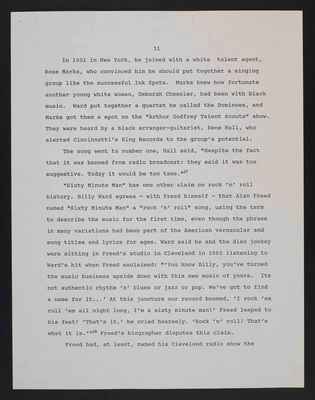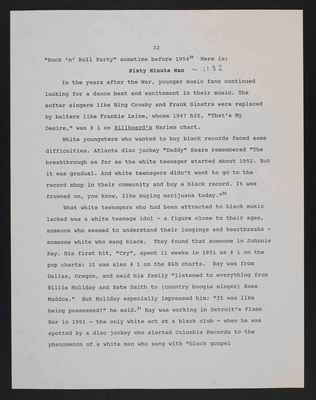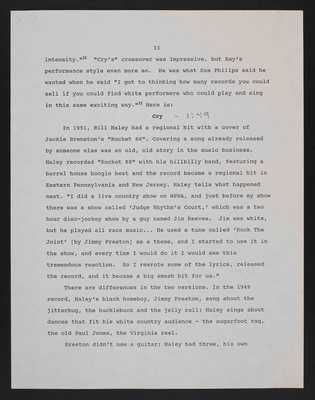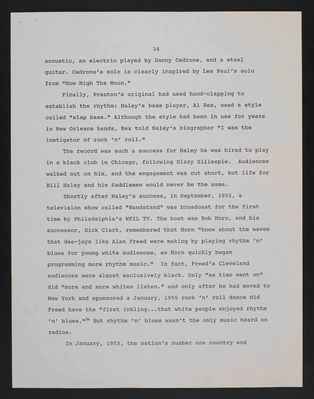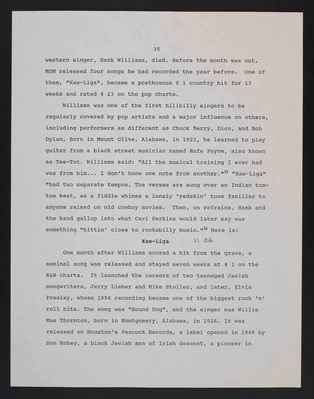Pages
31
31
In 1951 in New York, he joined with a white talent agent, Rose Marks, who convinced him he should put together a singing group like the successful Ink Spots. Marks knew how fortunate another young white woman, Deborah Chessler, had been with black music. Ward put together a quartet he called the Dominoes, and Marks got them a spot on the "Arthur Godfrey Talent Scouts" show. They were heard by a black arranger-guitarist, Rene Hall, who alerted Cincinnati's King Records to the group's potential.
The song went to number one, Hall said, "despite the fact that it was banned from radio broadcast; they said it was too suggestive. Today it would be too tame."27
"Sixty Minute Man" has one other claim on rock 'n' roll history. Billy Ward agrees - with Freed himself - that Alan Freed named "Sixty Minute Man" a "rock 'n' roll" song, using the term to describe the music for the first time, even though the phrase in many variations had been part of the American vernacular and song titles and lyrics for ages. Ward said he and the disc jockey were sitting in Freed's studio in Cleveland in 1953 listening to Ward's hit when Freed exclaimed: "'You know Billy, you've turned the music business upside down with this new music of yours. Its not authentic rhythm 'n' blues or jazz or pop. We've got to find a name for it...' At this juncture our record boomed, 'I rock 'em and roll 'em all night long. I'm a sixty minute man!' Freed leaped to his feet! 'That's it,' he cried hoarsely. 'Rock 'n' roll! That's what it is.'"28 Freed's biographer disputes this claim.
Freed had, at least, named his Cleveland radio show the
32
32
"Rock 'n' Roll Party" sometime before 195429 Here is:
Sixty Minute Man - 1:32
In the years after the War, younger music fans continued looking for a dance beat and excitement in their music. The softer singers like Bing Crosby and Frank Sinatra were replaced by belters like Frankie Laine, whose 1947 hit, "That's My Desire," was # 1 on Billboard's Harlem chart.
White youngsters who wanted to buy black records faced some difficulties. Atlanta disc jockey "Daddy" Sears remembered "The breakthrough as far as the white teenager started about 1952. But it was gradual. And white teenagers didn't want to go to the record shop in their community and buy a black record. It was frowned on, you know, like buying marijuana today."30
What white teenagers who had been attracted to black music lacked was a white teenage idol - a figure close to their ages, someone who seemed to understand their longings and heartbreaks - someone white who sang black. They found someone in Johnnie Ray. His first hit, "Cry", spent 11 weeks in 1951 as # 1 on the pop charts; it was also # 1 on the R&B charts. Ray was from Dallas, Oregon, and said his family "listened to everything from Billie Holiday and Kate Smith to (country boogie singer) Rose Maddox." But Holiday especially impressed him; "It was like being possessed!" he said.31 Ray was working in Detroit's Flame Bar in 1951 - the only white act at a black club - when he was spotted by a disc jockey who alerted Columbia Records to the phenomenon of a white man who sang with "black gospel
33
33
intensity."32 "Cry's" crossover was impressive, but Ray's performance style even more so. He was what Sam Philips said he wanted when he said, "I got to thinking how many records you could sell if you could find white performers who could play and sing in this same exciting way."33 Here is:
Cry - 1:49
In 1951, Bill Haley had a regional hit with a cover of Jackie Brenston's "Rocket 88". Covering a song already released by someone was an old, old story in the music business. Haley recorded "Rocket 88" with his hillbilly band, featuring a barrel house boogie beat and the record became a regional hit in Eastern Pennsylvania and New Jersey. Haley tells what happened next. "I did a live country show on WPWA, and just before my show there was a show called 'Judge Rhythm's Court,' which was a two hour disc-jockey show by a guy named Jim Reeves. Jim was white, but he played all race music... He used a tune called 'Rock The Joint' [by Jimmy Preston] as a theme, and I started to use it in the show, and every time I would do it I would see this tremendous reaction. So I rewrote some of the lyrics, released the record, and it became a big smash hit for us."
There are differences in the two versions. In the 1949 record, Haley's black homeboy, Jimmy Preston, sang about the jitterbug, the hucklebuck and the jelly roll; Haley sings about dances that fit his white country audience - the sugarfoot rag, the old Paul Jones, the Virginia reel.
Preston didn't use a guitar; Haley had three, his own
34
34
acoustic, and electric played by Danny Cedrone, and a steel guitar. Cedrone's solo is clearly inspired by Les Paul's solo from "How High The Moon."
Finally, Preston's original had used hand-clapping to establish the rhythm; Haley's bass player, Al Rex, used a style called "slap bass." Although the style had been in use for years in New Orleans bands, Rex told Haley's biographer "I was the instigator of rock 'n' roll."
The record was such a success for Haley he was hired to play in a black club in Chicago, following Dizzy Gillespie. Audiences walked out on him, and the engagement was cut short, but life for Bill Haley and his Saddlemen would never be the same.
Shortly after Haley's success, in September, 1952, a television show called "Bandstand" was broadcast for the first time by Philadelphia's WFIL TV. The host was Bob Horn, and his successor, Dick Clark, remembered that Horn "knew about the waves that dee-jays like Alan Freed were making by playing rhythm 'n' blues for young white audiences, so Horn quickly began programming more rhythm music." In fact, Freed's Cleveland audiences were almost exclusively black. Only "as time went on" did "more and more whites listen." and only after he had moved to New York and sponsored a January, 1955 rock 'n' roll dance did Freed have the "first inkling...that white people enjoyed rhythm 'n' blues."34 But rhythm 'n' blues wasn't the only music heard on radios.
In January, 1953, the nation's number one country and
35
35
western singer, Hank Williams, died. Before the month was out, MGM released four songs he had recorded the year before. One of them, "Kaw-Liga," became a posthumous # 1 country hit for 13 weeks and rated # 23 on the pop charts.
Williams was one of the first hillbilly singers to be regularly covered by pop artists and a major influence on others, including performers as different as Chuck Berry, Dion, and Bob Dylan. Born in Mount Olive, Alabama, in 1923, he learned to play guitar from a black street musician named Rufe Payne, also known as Tee-Tot. Williams said: "All the musical training I ever had was from him... I don't know one note from another."35 "Kaw-Liga" "had two separate tempos. The verses are sung over an Indian tom-tom beat, as a fiddle whines a lonely 'redskin' tune familiar to anyone raised on old cowboy movies. Then, on refrains, Hank and the band gallop into what Carl Perkins would later say was something "hittin' close to rockabilly music."36 Here is:
Kaw-Liga 1:06
One month after Williams scored a hit from the grave, a seminal song was released and stayed seven weeks at # 1 on the R&B charts. It launched the careers of two teenaged Jewish songwriters, Jerry Lieber and Mike Stoller, and later Elvis Presley, whose 1956 recording became one of the biggest rock 'n' roll hits. The song was "Hound Dog", and the singer was Willie Mae Thornton, born in Montgomery, Alabama, in 1926. It was released on Houston's Peacock Records, a label opened in 1949 by Don Robey, a black Jewish man of Irish descent, a pioneer in
